Management Accounting Project Report for GSQ Limited Analysis
VerifiedAdded on 2023/01/13
|19
|3384
|70
Project
AI Summary
This project report provides a comprehensive analysis of management accounting (MA) and its role in internal business management, using the case study of GSQ Limited. It explores various types of accounting systems, including cost accounting, stock management, price optimization, and job costing systems, highlighting their benefits and applications. The report also covers the importance of presenting reliable and understandable financial information, along with different types of reports like inventory reports and performance reports. Furthermore, the report delves into microeconomic techniques such as absorption and marginal costing, product costing, and standard costing, alongside the role of costing in price setting and inventory valuation methods. Finally, it examines planning tools used for budgetary control, including capital and operating budgets, and their advantages and disadvantages. The project aims to provide a detailed understanding of MA's significance in solving financial issues and improving business operations.
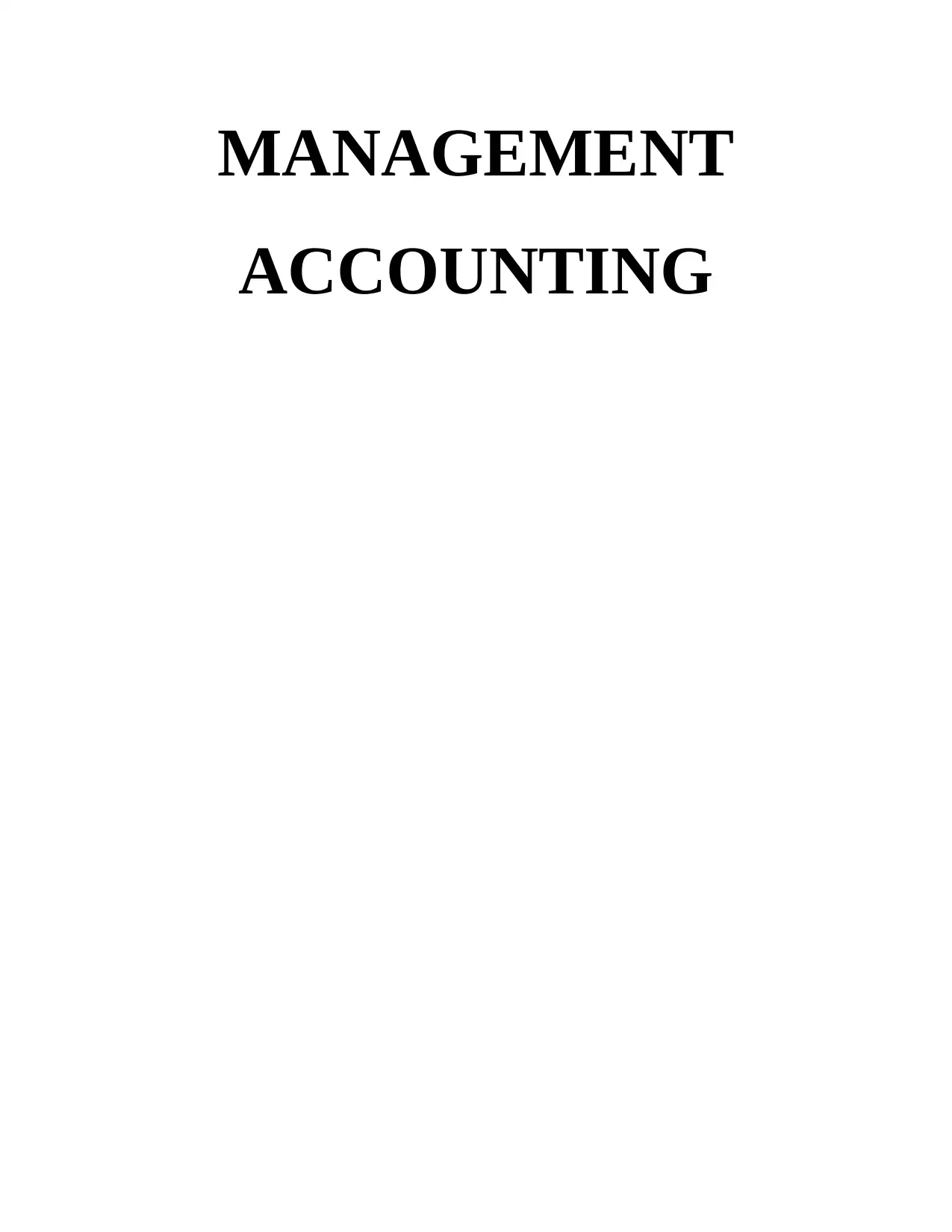
MANAGEMENT
ACCOUNTING
ACCOUNTING
Paraphrase This Document
Need a fresh take? Get an instant paraphrase of this document with our AI Paraphraser
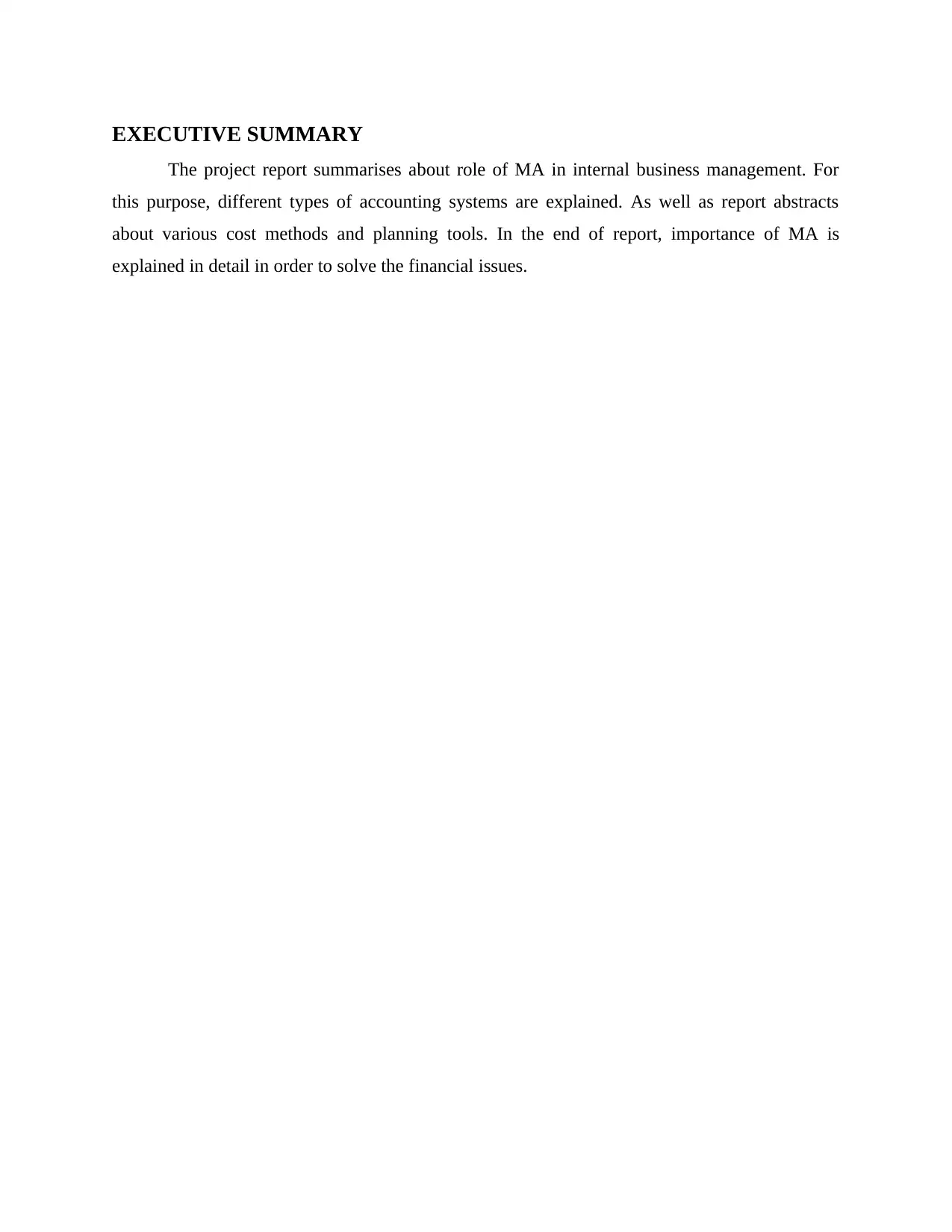
EXECUTIVE SUMMARY
The project report summarises about role of MA in internal business management. For
this purpose, different types of accounting systems are explained. As well as report abstracts
about various cost methods and planning tools. In the end of report, importance of MA is
explained in detail in order to solve the financial issues.
The project report summarises about role of MA in internal business management. For
this purpose, different types of accounting systems are explained. As well as report abstracts
about various cost methods and planning tools. In the end of report, importance of MA is
explained in detail in order to solve the financial issues.
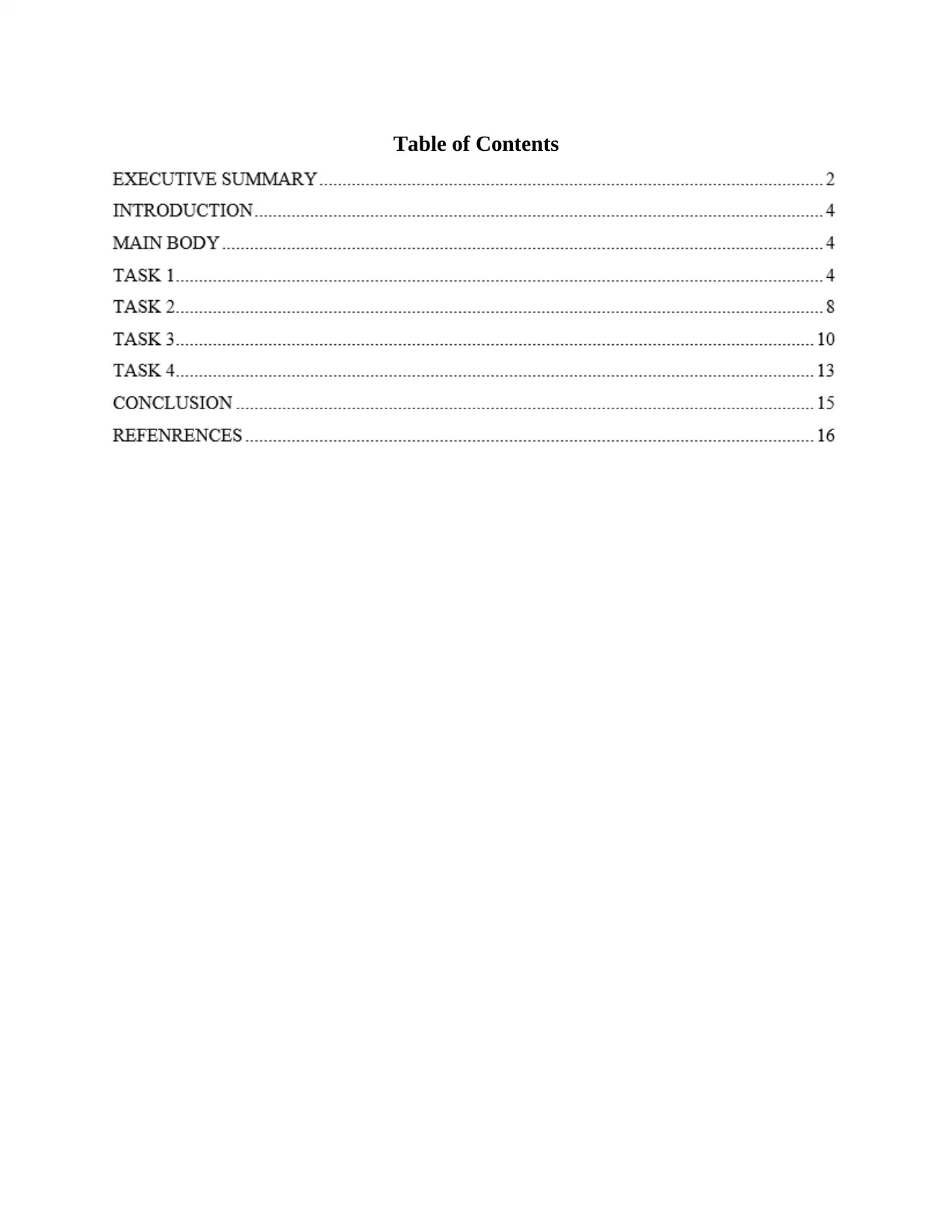
Table of Contents
⊘ This is a preview!⊘
Do you want full access?
Subscribe today to unlock all pages.

Trusted by 1+ million students worldwide
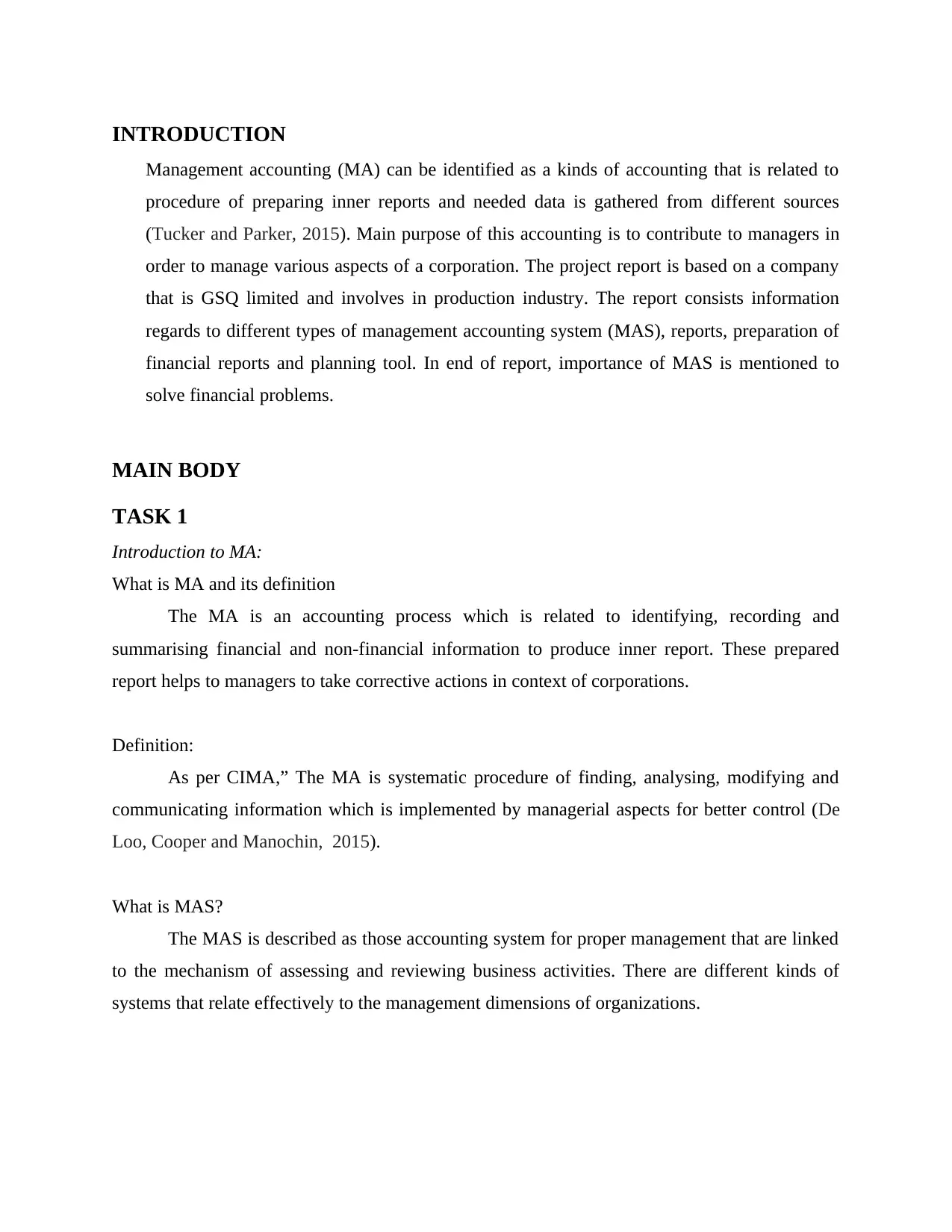
INTRODUCTION
Management accounting (MA) can be identified as a kinds of accounting that is related to
procedure of preparing inner reports and needed data is gathered from different sources
(Tucker and Parker, 2015). Main purpose of this accounting is to contribute to managers in
order to manage various aspects of a corporation. The project report is based on a company
that is GSQ limited and involves in production industry. The report consists information
regards to different types of management accounting system (MAS), reports, preparation of
financial reports and planning tool. In end of report, importance of MAS is mentioned to
solve financial problems.
MAIN BODY
TASK 1
Introduction to MA:
What is MA and its definition
The MA is an accounting process which is related to identifying, recording and
summarising financial and non-financial information to produce inner report. These prepared
report helps to managers to take corrective actions in context of corporations.
Definition:
As per CIMA,” The MA is systematic procedure of finding, analysing, modifying and
communicating information which is implemented by managerial aspects for better control (De
Loo, Cooper and Manochin, 2015).
What is MAS?
The MAS is described as those accounting system for proper management that are linked
to the mechanism of assessing and reviewing business activities. There are different kinds of
systems that relate effectively to the management dimensions of organizations.
Management accounting (MA) can be identified as a kinds of accounting that is related to
procedure of preparing inner reports and needed data is gathered from different sources
(Tucker and Parker, 2015). Main purpose of this accounting is to contribute to managers in
order to manage various aspects of a corporation. The project report is based on a company
that is GSQ limited and involves in production industry. The report consists information
regards to different types of management accounting system (MAS), reports, preparation of
financial reports and planning tool. In end of report, importance of MAS is mentioned to
solve financial problems.
MAIN BODY
TASK 1
Introduction to MA:
What is MA and its definition
The MA is an accounting process which is related to identifying, recording and
summarising financial and non-financial information to produce inner report. These prepared
report helps to managers to take corrective actions in context of corporations.
Definition:
As per CIMA,” The MA is systematic procedure of finding, analysing, modifying and
communicating information which is implemented by managerial aspects for better control (De
Loo, Cooper and Manochin, 2015).
What is MAS?
The MAS is described as those accounting system for proper management that are linked
to the mechanism of assessing and reviewing business activities. There are different kinds of
systems that relate effectively to the management dimensions of organizations.
Paraphrase This Document
Need a fresh take? Get an instant paraphrase of this document with our AI Paraphraser
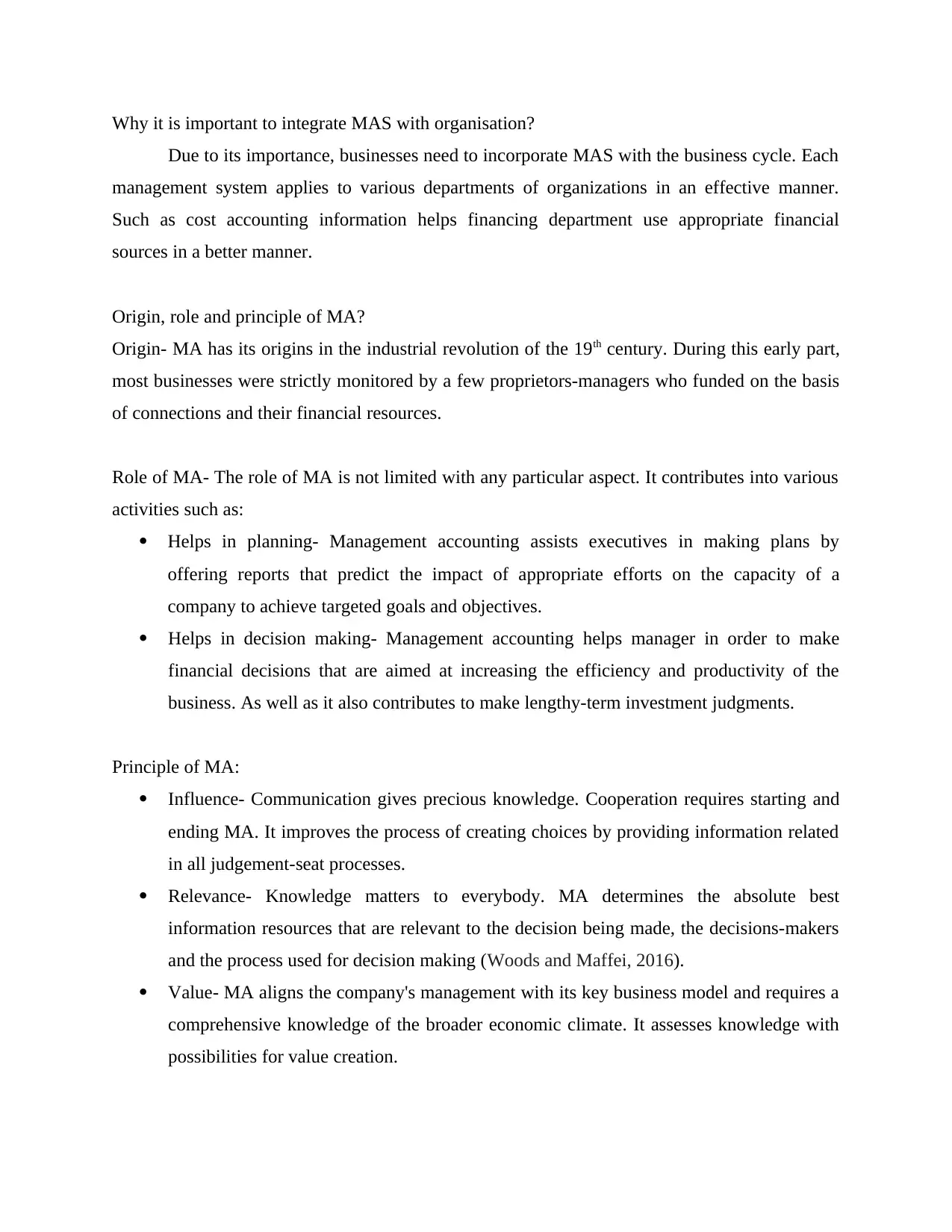
Why it is important to integrate MAS with organisation?
Due to its importance, businesses need to incorporate MAS with the business cycle. Each
management system applies to various departments of organizations in an effective manner.
Such as cost accounting information helps financing department use appropriate financial
sources in a better manner.
Origin, role and principle of MA?
Origin- MA has its origins in the industrial revolution of the 19th century. During this early part,
most businesses were strictly monitored by a few proprietors-managers who funded on the basis
of connections and their financial resources.
Role of MA- The role of MA is not limited with any particular aspect. It contributes into various
activities such as:
Helps in planning- Management accounting assists executives in making plans by
offering reports that predict the impact of appropriate efforts on the capacity of a
company to achieve targeted goals and objectives.
Helps in decision making- Management accounting helps manager in order to make
financial decisions that are aimed at increasing the efficiency and productivity of the
business. As well as it also contributes to make lengthy-term investment judgments.
Principle of MA:
Influence- Communication gives precious knowledge. Cooperation requires starting and
ending MA. It improves the process of creating choices by providing information related
in all judgement-seat processes.
Relevance- Knowledge matters to everybody. MA determines the absolute best
information resources that are relevant to the decision being made, the decisions-makers
and the process used for decision making (Woods and Maffei, 2016).
Value- MA aligns the company's management with its key business model and requires a
comprehensive knowledge of the broader economic climate. It assesses knowledge with
possibilities for value creation.
Due to its importance, businesses need to incorporate MAS with the business cycle. Each
management system applies to various departments of organizations in an effective manner.
Such as cost accounting information helps financing department use appropriate financial
sources in a better manner.
Origin, role and principle of MA?
Origin- MA has its origins in the industrial revolution of the 19th century. During this early part,
most businesses were strictly monitored by a few proprietors-managers who funded on the basis
of connections and their financial resources.
Role of MA- The role of MA is not limited with any particular aspect. It contributes into various
activities such as:
Helps in planning- Management accounting assists executives in making plans by
offering reports that predict the impact of appropriate efforts on the capacity of a
company to achieve targeted goals and objectives.
Helps in decision making- Management accounting helps manager in order to make
financial decisions that are aimed at increasing the efficiency and productivity of the
business. As well as it also contributes to make lengthy-term investment judgments.
Principle of MA:
Influence- Communication gives precious knowledge. Cooperation requires starting and
ending MA. It improves the process of creating choices by providing information related
in all judgement-seat processes.
Relevance- Knowledge matters to everybody. MA determines the absolute best
information resources that are relevant to the decision being made, the decisions-makers
and the process used for decision making (Woods and Maffei, 2016).
Value- MA aligns the company's management with its key business model and requires a
comprehensive knowledge of the broader economic climate. It assesses knowledge with
possibilities for value creation.
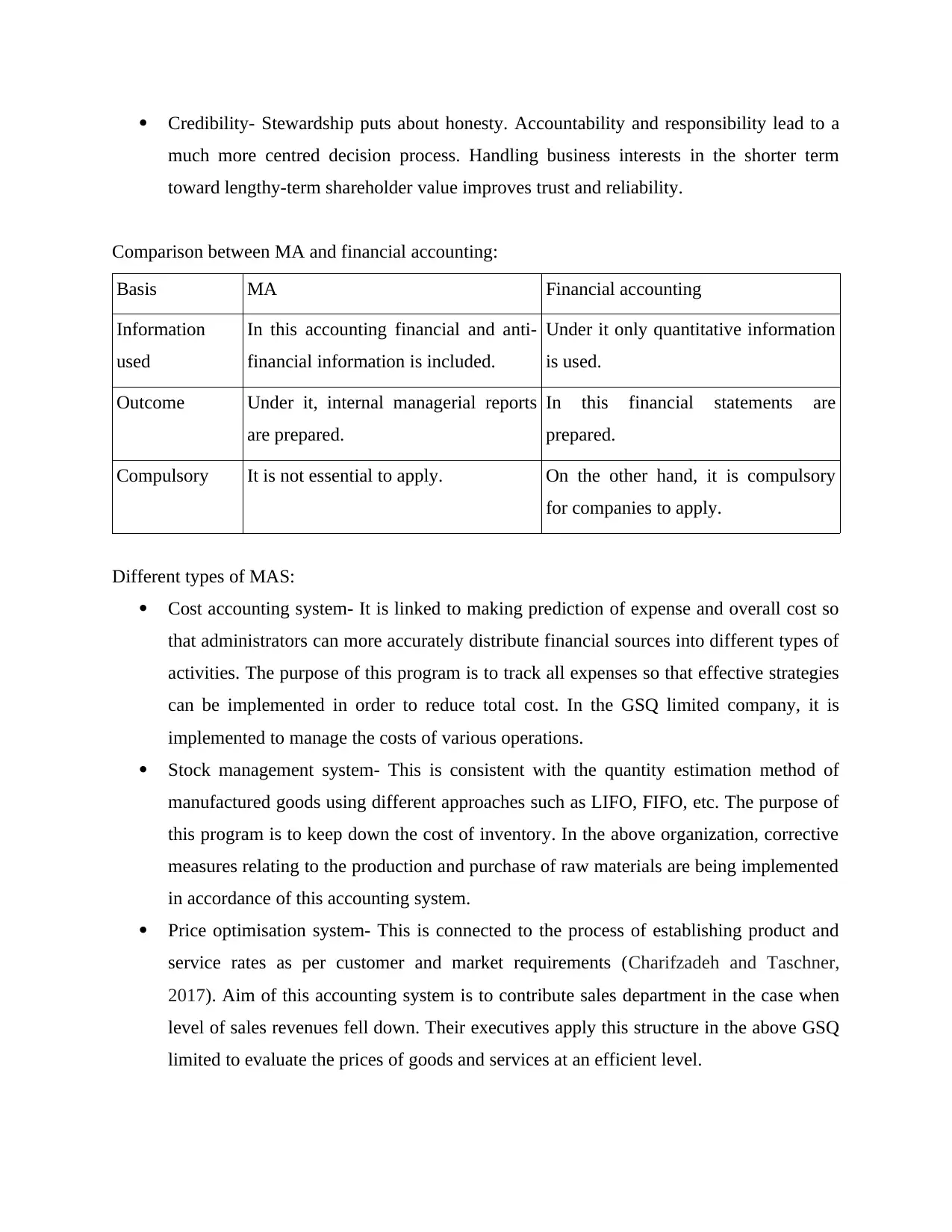
Credibility- Stewardship puts about honesty. Accountability and responsibility lead to a
much more centred decision process. Handling business interests in the shorter term
toward lengthy-term shareholder value improves trust and reliability.
Comparison between MA and financial accounting:
Basis MA Financial accounting
Information
used
In this accounting financial and anti-
financial information is included.
Under it only quantitative information
is used.
Outcome Under it, internal managerial reports
are prepared.
In this financial statements are
prepared.
Compulsory It is not essential to apply. On the other hand, it is compulsory
for companies to apply.
Different types of MAS:
Cost accounting system- It is linked to making prediction of expense and overall cost so
that administrators can more accurately distribute financial sources into different types of
activities. The purpose of this program is to track all expenses so that effective strategies
can be implemented in order to reduce total cost. In the GSQ limited company, it is
implemented to manage the costs of various operations.
Stock management system- This is consistent with the quantity estimation method of
manufactured goods using different approaches such as LIFO, FIFO, etc. The purpose of
this program is to keep down the cost of inventory. In the above organization, corrective
measures relating to the production and purchase of raw materials are being implemented
in accordance of this accounting system.
Price optimisation system- This is connected to the process of establishing product and
service rates as per customer and market requirements (Charifzadeh and Taschner,
2017). Aim of this accounting system is to contribute sales department in the case when
level of sales revenues fell down. Their executives apply this structure in the above GSQ
limited to evaluate the prices of goods and services at an efficient level.
much more centred decision process. Handling business interests in the shorter term
toward lengthy-term shareholder value improves trust and reliability.
Comparison between MA and financial accounting:
Basis MA Financial accounting
Information
used
In this accounting financial and anti-
financial information is included.
Under it only quantitative information
is used.
Outcome Under it, internal managerial reports
are prepared.
In this financial statements are
prepared.
Compulsory It is not essential to apply. On the other hand, it is compulsory
for companies to apply.
Different types of MAS:
Cost accounting system- It is linked to making prediction of expense and overall cost so
that administrators can more accurately distribute financial sources into different types of
activities. The purpose of this program is to track all expenses so that effective strategies
can be implemented in order to reduce total cost. In the GSQ limited company, it is
implemented to manage the costs of various operations.
Stock management system- This is consistent with the quantity estimation method of
manufactured goods using different approaches such as LIFO, FIFO, etc. The purpose of
this program is to keep down the cost of inventory. In the above organization, corrective
measures relating to the production and purchase of raw materials are being implemented
in accordance of this accounting system.
Price optimisation system- This is connected to the process of establishing product and
service rates as per customer and market requirements (Charifzadeh and Taschner,
2017). Aim of this accounting system is to contribute sales department in the case when
level of sales revenues fell down. Their executives apply this structure in the above GSQ
limited to evaluate the prices of goods and services at an efficient level.
⊘ This is a preview!⊘
Do you want full access?
Subscribe today to unlock all pages.

Trusted by 1+ million students worldwide
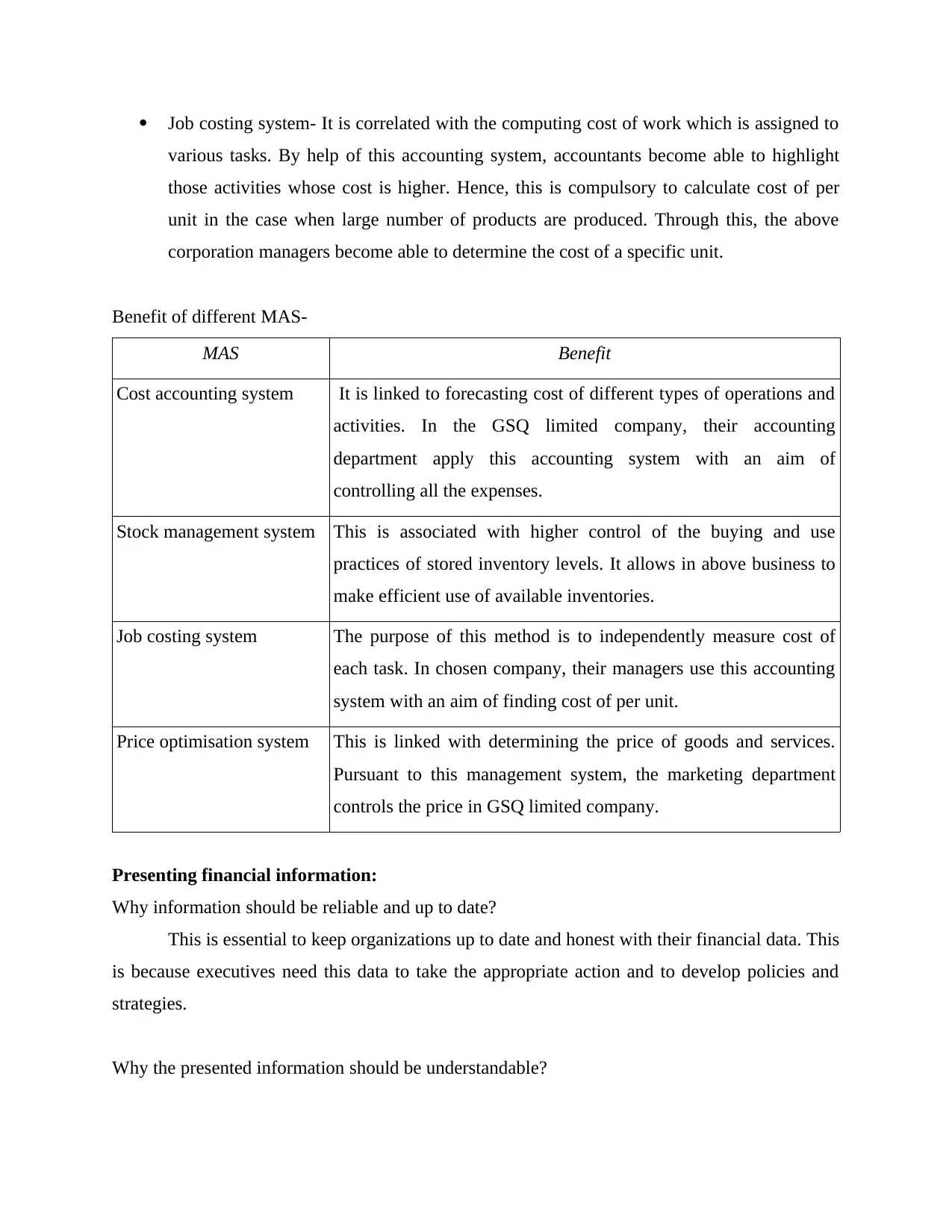
Job costing system- It is correlated with the computing cost of work which is assigned to
various tasks. By help of this accounting system, accountants become able to highlight
those activities whose cost is higher. Hence, this is compulsory to calculate cost of per
unit in the case when large number of products are produced. Through this, the above
corporation managers become able to determine the cost of a specific unit.
Benefit of different MAS-
MAS Benefit
Cost accounting system It is linked to forecasting cost of different types of operations and
activities. In the GSQ limited company, their accounting
department apply this accounting system with an aim of
controlling all the expenses.
Stock management system This is associated with higher control of the buying and use
practices of stored inventory levels. It allows in above business to
make efficient use of available inventories.
Job costing system The purpose of this method is to independently measure cost of
each task. In chosen company, their managers use this accounting
system with an aim of finding cost of per unit.
Price optimisation system This is linked with determining the price of goods and services.
Pursuant to this management system, the marketing department
controls the price in GSQ limited company.
Presenting financial information:
Why information should be reliable and up to date?
This is essential to keep organizations up to date and honest with their financial data. This
is because executives need this data to take the appropriate action and to develop policies and
strategies.
Why the presented information should be understandable?
various tasks. By help of this accounting system, accountants become able to highlight
those activities whose cost is higher. Hence, this is compulsory to calculate cost of per
unit in the case when large number of products are produced. Through this, the above
corporation managers become able to determine the cost of a specific unit.
Benefit of different MAS-
MAS Benefit
Cost accounting system It is linked to forecasting cost of different types of operations and
activities. In the GSQ limited company, their accounting
department apply this accounting system with an aim of
controlling all the expenses.
Stock management system This is associated with higher control of the buying and use
practices of stored inventory levels. It allows in above business to
make efficient use of available inventories.
Job costing system The purpose of this method is to independently measure cost of
each task. In chosen company, their managers use this accounting
system with an aim of finding cost of per unit.
Price optimisation system This is linked with determining the price of goods and services.
Pursuant to this management system, the marketing department
controls the price in GSQ limited company.
Presenting financial information:
Why information should be reliable and up to date?
This is essential to keep organizations up to date and honest with their financial data. This
is because executives need this data to take the appropriate action and to develop policies and
strategies.
Why the presented information should be understandable?
Paraphrase This Document
Need a fresh take? Get an instant paraphrase of this document with our AI Paraphraser
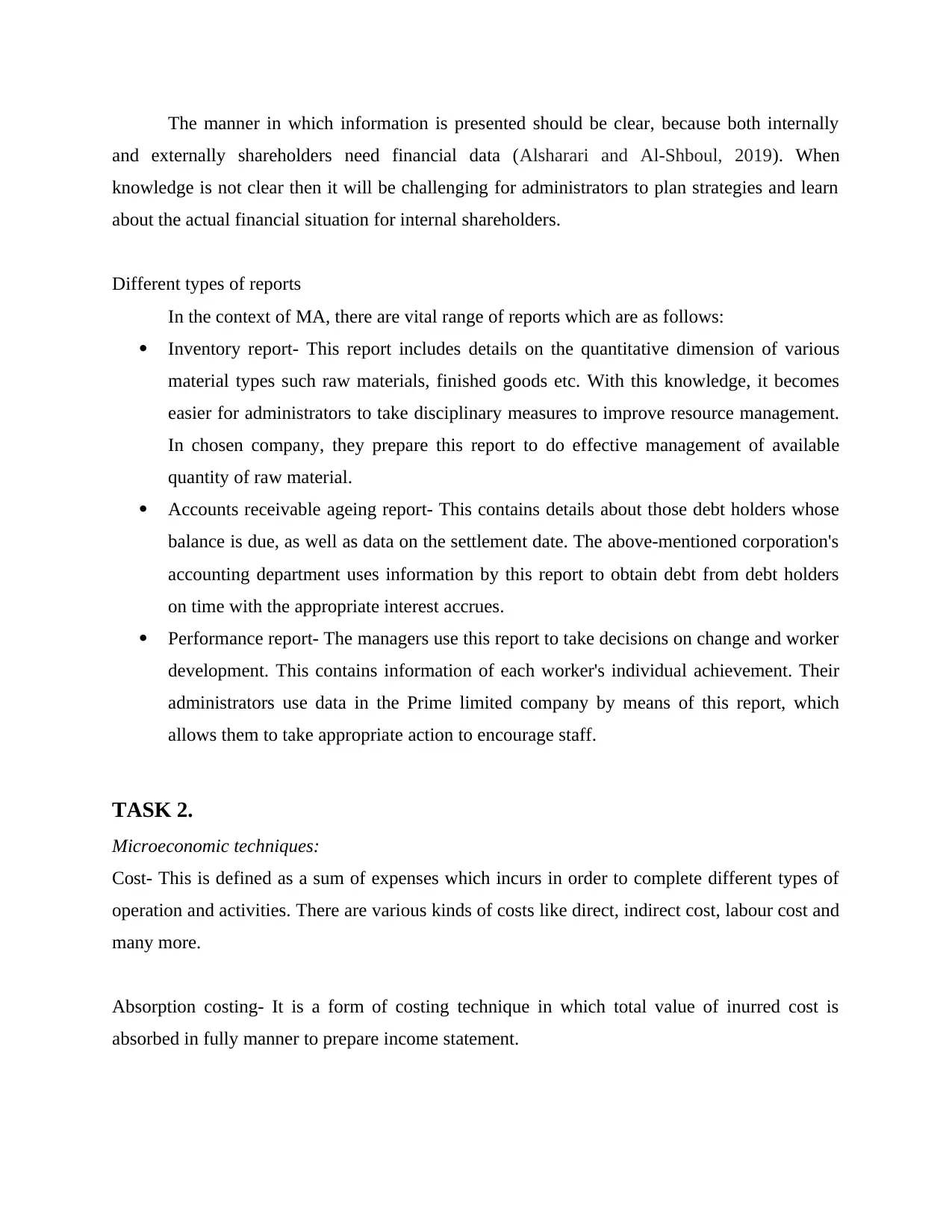
The manner in which information is presented should be clear, because both internally
and externally shareholders need financial data (Alsharari and Al-Shboul, 2019). When
knowledge is not clear then it will be challenging for administrators to plan strategies and learn
about the actual financial situation for internal shareholders.
Different types of reports
In the context of MA, there are vital range of reports which are as follows:
Inventory report- This report includes details on the quantitative dimension of various
material types such raw materials, finished goods etc. With this knowledge, it becomes
easier for administrators to take disciplinary measures to improve resource management.
In chosen company, they prepare this report to do effective management of available
quantity of raw material.
Accounts receivable ageing report- This contains details about those debt holders whose
balance is due, as well as data on the settlement date. The above-mentioned corporation's
accounting department uses information by this report to obtain debt from debt holders
on time with the appropriate interest accrues.
Performance report- The managers use this report to take decisions on change and worker
development. This contains information of each worker's individual achievement. Their
administrators use data in the Prime limited company by means of this report, which
allows them to take appropriate action to encourage staff.
TASK 2.
Microeconomic techniques:
Cost- This is defined as a sum of expenses which incurs in order to complete different types of
operation and activities. There are various kinds of costs like direct, indirect cost, labour cost and
many more.
Absorption costing- It is a form of costing technique in which total value of inurred cost is
absorbed in fully manner to prepare income statement.
and externally shareholders need financial data (Alsharari and Al-Shboul, 2019). When
knowledge is not clear then it will be challenging for administrators to plan strategies and learn
about the actual financial situation for internal shareholders.
Different types of reports
In the context of MA, there are vital range of reports which are as follows:
Inventory report- This report includes details on the quantitative dimension of various
material types such raw materials, finished goods etc. With this knowledge, it becomes
easier for administrators to take disciplinary measures to improve resource management.
In chosen company, they prepare this report to do effective management of available
quantity of raw material.
Accounts receivable ageing report- This contains details about those debt holders whose
balance is due, as well as data on the settlement date. The above-mentioned corporation's
accounting department uses information by this report to obtain debt from debt holders
on time with the appropriate interest accrues.
Performance report- The managers use this report to take decisions on change and worker
development. This contains information of each worker's individual achievement. Their
administrators use data in the Prime limited company by means of this report, which
allows them to take appropriate action to encourage staff.
TASK 2.
Microeconomic techniques:
Cost- This is defined as a sum of expenses which incurs in order to complete different types of
operation and activities. There are various kinds of costs like direct, indirect cost, labour cost and
many more.
Absorption costing- It is a form of costing technique in which total value of inurred cost is
absorbed in fully manner to prepare income statement.
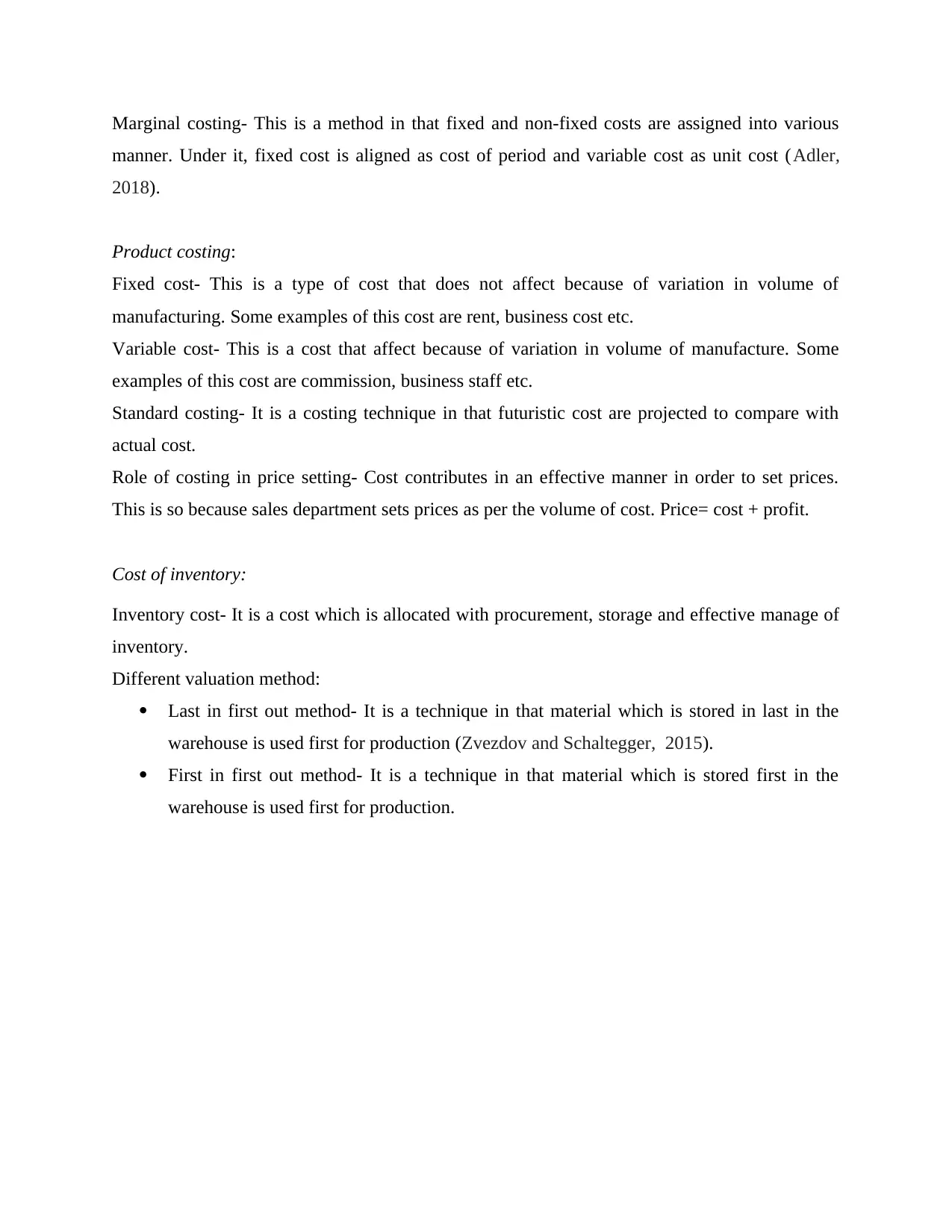
Marginal costing- This is a method in that fixed and non-fixed costs are assigned into various
manner. Under it, fixed cost is aligned as cost of period and variable cost as unit cost (Adler,
2018).
Product costing:
Fixed cost- This is a type of cost that does not affect because of variation in volume of
manufacturing. Some examples of this cost are rent, business cost etc.
Variable cost- This is a cost that affect because of variation in volume of manufacture. Some
examples of this cost are commission, business staff etc.
Standard costing- It is a costing technique in that futuristic cost are projected to compare with
actual cost.
Role of costing in price setting- Cost contributes in an effective manner in order to set prices.
This is so because sales department sets prices as per the volume of cost. Price= cost + profit.
Cost of inventory:
Inventory cost- It is a cost which is allocated with procurement, storage and effective manage of
inventory.
Different valuation method:
Last in first out method- It is a technique in that material which is stored in last in the
warehouse is used first for production (Zvezdov and Schaltegger, 2015).
First in first out method- It is a technique in that material which is stored first in the
warehouse is used first for production.
manner. Under it, fixed cost is aligned as cost of period and variable cost as unit cost (Adler,
2018).
Product costing:
Fixed cost- This is a type of cost that does not affect because of variation in volume of
manufacturing. Some examples of this cost are rent, business cost etc.
Variable cost- This is a cost that affect because of variation in volume of manufacture. Some
examples of this cost are commission, business staff etc.
Standard costing- It is a costing technique in that futuristic cost are projected to compare with
actual cost.
Role of costing in price setting- Cost contributes in an effective manner in order to set prices.
This is so because sales department sets prices as per the volume of cost. Price= cost + profit.
Cost of inventory:
Inventory cost- It is a cost which is allocated with procurement, storage and effective manage of
inventory.
Different valuation method:
Last in first out method- It is a technique in that material which is stored in last in the
warehouse is used first for production (Zvezdov and Schaltegger, 2015).
First in first out method- It is a technique in that material which is stored first in the
warehouse is used first for production.
⊘ This is a preview!⊘
Do you want full access?
Subscribe today to unlock all pages.

Trusted by 1+ million students worldwide
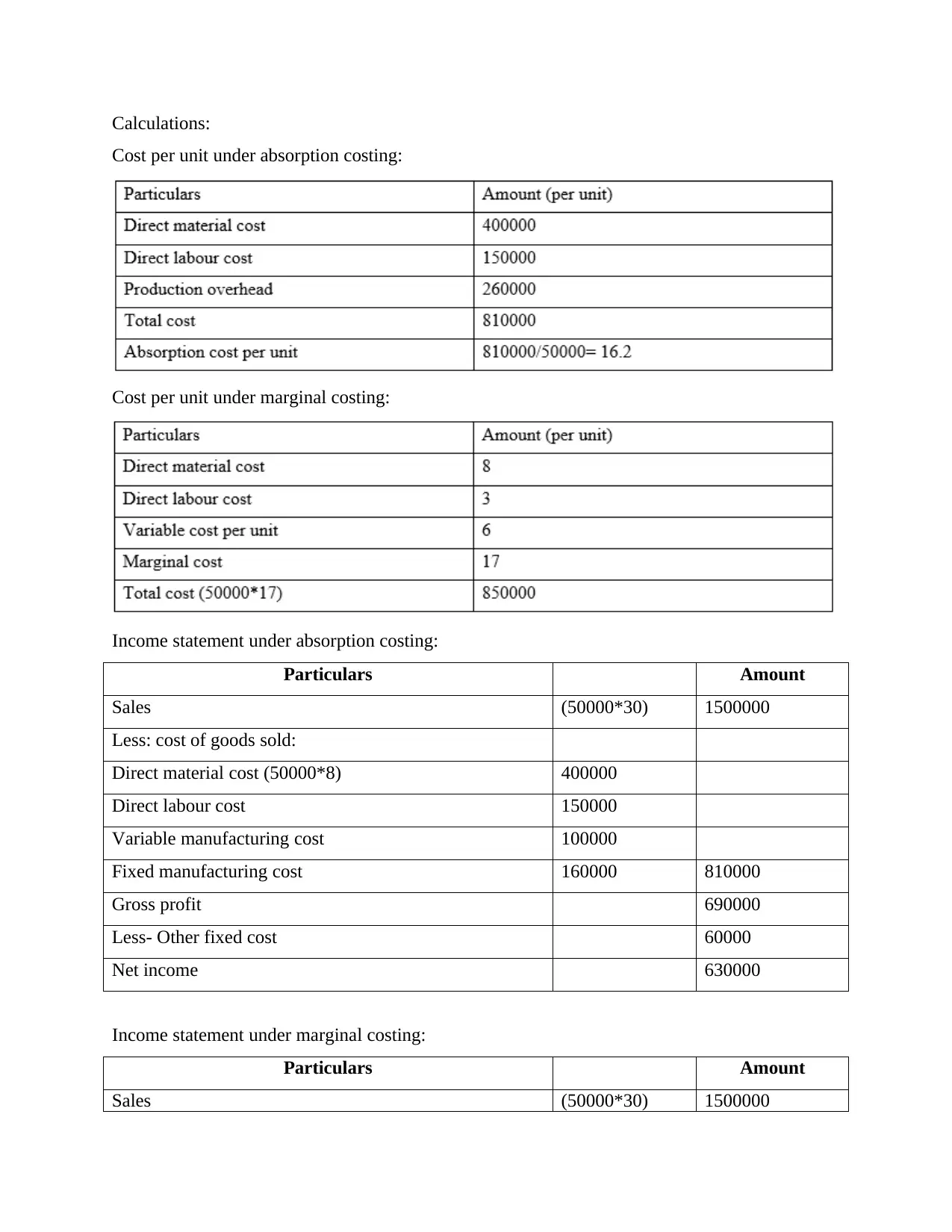
Calculations:
Cost per unit under absorption costing:
Cost per unit under marginal costing:
Income statement under absorption costing:
Particulars Amount
Sales (50000*30) 1500000
Less: cost of goods sold:
Direct material cost (50000*8) 400000
Direct labour cost 150000
Variable manufacturing cost 100000
Fixed manufacturing cost 160000 810000
Gross profit 690000
Less- Other fixed cost 60000
Net income 630000
Income statement under marginal costing:
Particulars Amount
Sales (50000*30) 1500000
Cost per unit under absorption costing:
Cost per unit under marginal costing:
Income statement under absorption costing:
Particulars Amount
Sales (50000*30) 1500000
Less: cost of goods sold:
Direct material cost (50000*8) 400000
Direct labour cost 150000
Variable manufacturing cost 100000
Fixed manufacturing cost 160000 810000
Gross profit 690000
Less- Other fixed cost 60000
Net income 630000
Income statement under marginal costing:
Particulars Amount
Sales (50000*30) 1500000
Paraphrase This Document
Need a fresh take? Get an instant paraphrase of this document with our AI Paraphraser
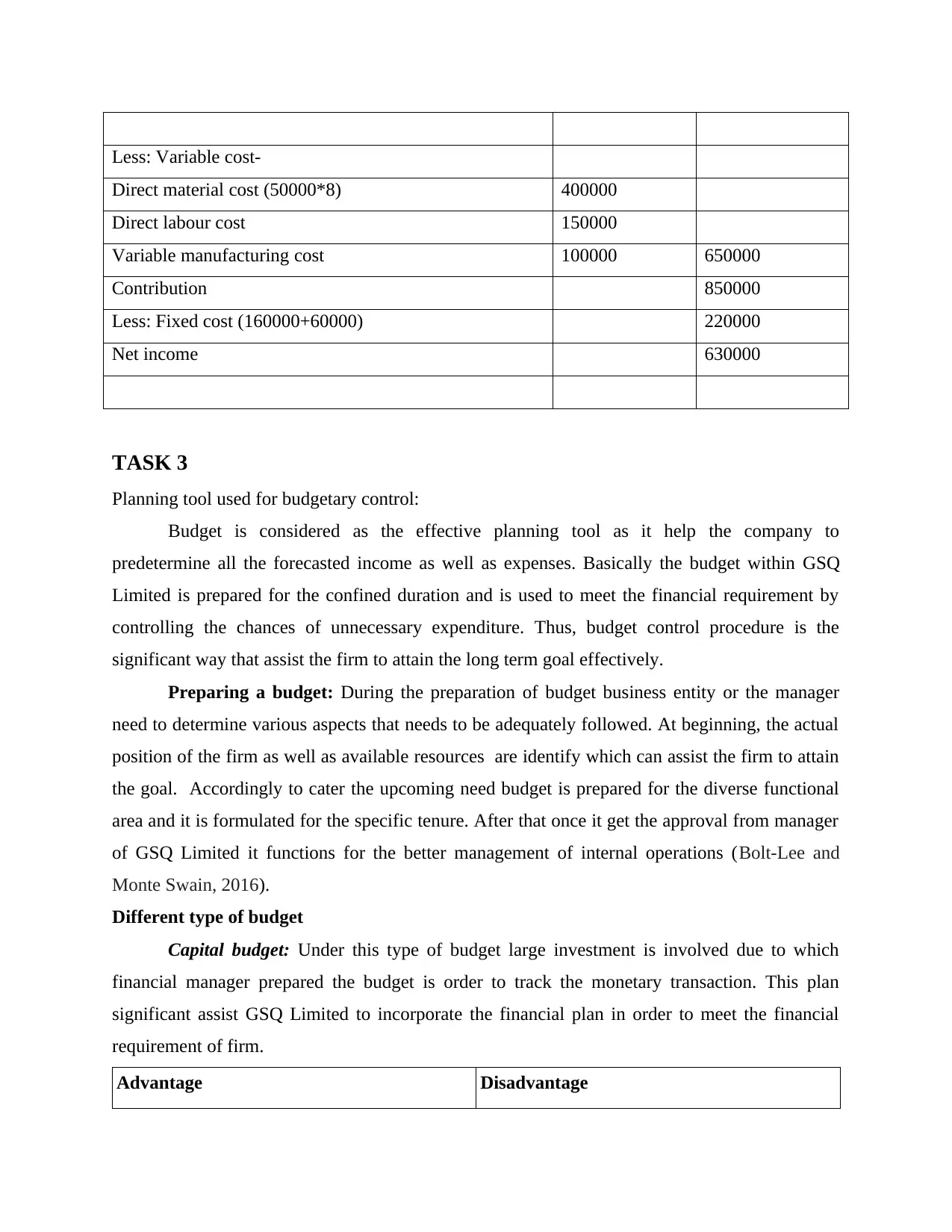
Less: Variable cost-
Direct material cost (50000*8) 400000
Direct labour cost 150000
Variable manufacturing cost 100000 650000
Contribution 850000
Less: Fixed cost (160000+60000) 220000
Net income 630000
TASK 3
Planning tool used for budgetary control:
Budget is considered as the effective planning tool as it help the company to
predetermine all the forecasted income as well as expenses. Basically the budget within GSQ
Limited is prepared for the confined duration and is used to meet the financial requirement by
controlling the chances of unnecessary expenditure. Thus, budget control procedure is the
significant way that assist the firm to attain the long term goal effectively.
Preparing a budget: During the preparation of budget business entity or the manager
need to determine various aspects that needs to be adequately followed. At beginning, the actual
position of the firm as well as available resources are identify which can assist the firm to attain
the goal. Accordingly to cater the upcoming need budget is prepared for the diverse functional
area and it is formulated for the specific tenure. After that once it get the approval from manager
of GSQ Limited it functions for the better management of internal operations (Bolt-Lee and
Monte Swain, 2016).
Different type of budget
Capital budget: Under this type of budget large investment is involved due to which
financial manager prepared the budget is order to track the monetary transaction. This plan
significant assist GSQ Limited to incorporate the financial plan in order to meet the financial
requirement of firm.
Advantage Disadvantage
Direct material cost (50000*8) 400000
Direct labour cost 150000
Variable manufacturing cost 100000 650000
Contribution 850000
Less: Fixed cost (160000+60000) 220000
Net income 630000
TASK 3
Planning tool used for budgetary control:
Budget is considered as the effective planning tool as it help the company to
predetermine all the forecasted income as well as expenses. Basically the budget within GSQ
Limited is prepared for the confined duration and is used to meet the financial requirement by
controlling the chances of unnecessary expenditure. Thus, budget control procedure is the
significant way that assist the firm to attain the long term goal effectively.
Preparing a budget: During the preparation of budget business entity or the manager
need to determine various aspects that needs to be adequately followed. At beginning, the actual
position of the firm as well as available resources are identify which can assist the firm to attain
the goal. Accordingly to cater the upcoming need budget is prepared for the diverse functional
area and it is formulated for the specific tenure. After that once it get the approval from manager
of GSQ Limited it functions for the better management of internal operations (Bolt-Lee and
Monte Swain, 2016).
Different type of budget
Capital budget: Under this type of budget large investment is involved due to which
financial manager prepared the budget is order to track the monetary transaction. This plan
significant assist GSQ Limited to incorporate the financial plan in order to meet the financial
requirement of firm.
Advantage Disadvantage
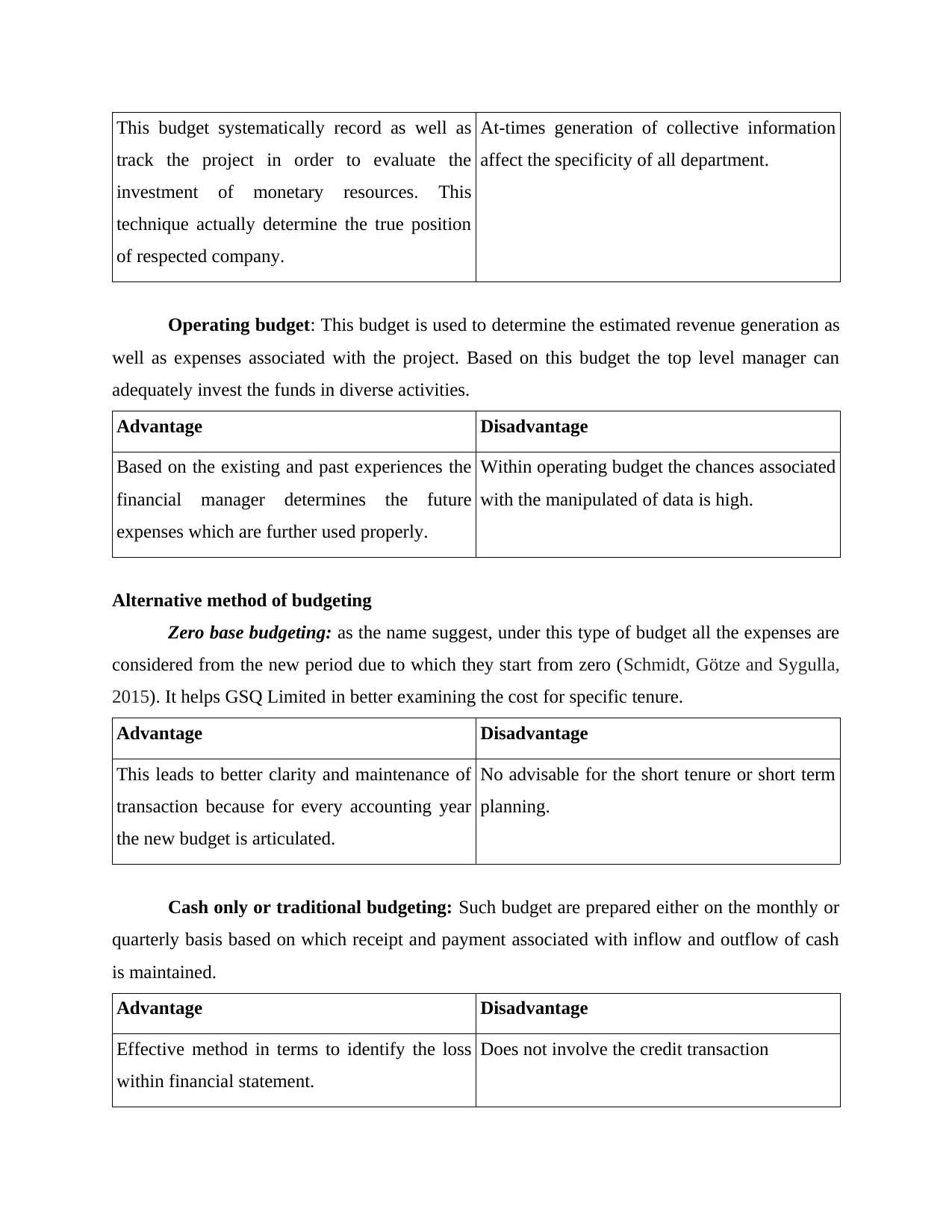
This budget systematically record as well as
track the project in order to evaluate the
investment of monetary resources. This
technique actually determine the true position
of respected company.
At-times generation of collective information
affect the specificity of all department.
Operating budget: This budget is used to determine the estimated revenue generation as
well as expenses associated with the project. Based on this budget the top level manager can
adequately invest the funds in diverse activities.
Advantage Disadvantage
Based on the existing and past experiences the
financial manager determines the future
expenses which are further used properly.
Within operating budget the chances associated
with the manipulated of data is high.
Alternative method of budgeting
Zero base budgeting: as the name suggest, under this type of budget all the expenses are
considered from the new period due to which they start from zero (Schmidt, Götze and Sygulla,
2015). It helps GSQ Limited in better examining the cost for specific tenure.
Advantage Disadvantage
This leads to better clarity and maintenance of
transaction because for every accounting year
the new budget is articulated.
No advisable for the short tenure or short term
planning.
Cash only or traditional budgeting: Such budget are prepared either on the monthly or
quarterly basis based on which receipt and payment associated with inflow and outflow of cash
is maintained.
Advantage Disadvantage
Effective method in terms to identify the loss
within financial statement.
Does not involve the credit transaction
track the project in order to evaluate the
investment of monetary resources. This
technique actually determine the true position
of respected company.
At-times generation of collective information
affect the specificity of all department.
Operating budget: This budget is used to determine the estimated revenue generation as
well as expenses associated with the project. Based on this budget the top level manager can
adequately invest the funds in diverse activities.
Advantage Disadvantage
Based on the existing and past experiences the
financial manager determines the future
expenses which are further used properly.
Within operating budget the chances associated
with the manipulated of data is high.
Alternative method of budgeting
Zero base budgeting: as the name suggest, under this type of budget all the expenses are
considered from the new period due to which they start from zero (Schmidt, Götze and Sygulla,
2015). It helps GSQ Limited in better examining the cost for specific tenure.
Advantage Disadvantage
This leads to better clarity and maintenance of
transaction because for every accounting year
the new budget is articulated.
No advisable for the short tenure or short term
planning.
Cash only or traditional budgeting: Such budget are prepared either on the monthly or
quarterly basis based on which receipt and payment associated with inflow and outflow of cash
is maintained.
Advantage Disadvantage
Effective method in terms to identify the loss
within financial statement.
Does not involve the credit transaction
⊘ This is a preview!⊘
Do you want full access?
Subscribe today to unlock all pages.

Trusted by 1+ million students worldwide
1 out of 19
Related Documents
Your All-in-One AI-Powered Toolkit for Academic Success.
+13062052269
info@desklib.com
Available 24*7 on WhatsApp / Email
![[object Object]](/_next/static/media/star-bottom.7253800d.svg)
Unlock your academic potential
Copyright © 2020–2025 A2Z Services. All Rights Reserved. Developed and managed by ZUCOL.





